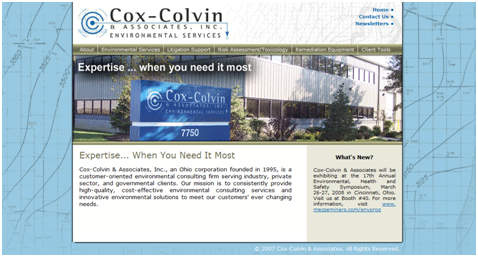Cox-Colvin & Associates, Inc., in cooperation with the Michigan DEQ, completed a comparative study of sub-slab soil-gas sampling equipment to evaluate the Vapor Pin as an acceptable technology for vapor intrusion studies. The study demonstrated that samples collected through the Vapor Pin were consistent with those collected by other means. As a result, a SOP on the use of the Vapor Pin has been included as Appendix D.7 of Michigan DEQ's January 2012 Draft Vapor Intrusion Guidance - "Sample Collection and Evaluation of the Vapor Intrusion to the Indoor Air Pathway When the Generic Criteria Do Not Apply". (See p. 167 of the pdf for the Vapor Pin SOP).
Cox-Colvin is participating in a similar study in California in late April, in cooperation with H&P Mobile Geochemistry, Inc. Results of the Michigan and California studies are being submitted as a presentation topic at the October 2012 AWMA Conference in Denver, CO.
Click here for more information on the Vapor Pin.
Wednesday, April 25, 2012
Friday, April 20, 2012
EPA Releases Vapor Intrusion FAQs
EPA recently posted Vapor Intrusion FAQs (frequently asked questions) on its Vapor Intrusion (VI) website. This 56-page document is much more than the average fact sheet, and provides a preview of what the much anticipated final VI guidance is likely to look like.
Read More>>
Labels:
Johnson Ettinger,
soil gas,
soil-gas,
sub-slab,
subslab,
vapor intrusion
Tuesday, April 17, 2012
Cox-Colvin to present on Innovative Subslab Soil-Gas Sampling Methods
Cox-Colvin employee Mort Schmidt will be presenting at A&WMA's 'Air Quality Measurement Methods and Technology' Conference to be held April 24 - 26, 2012 in Durham, North Carolina. Mort will be presenting his talk, entitled "Innovative Sampling Methods for Focusing the Subslab Soil-Gas Investigation" on Wednesday, April 25th @ 2:45 pm (Session 7A). Mort's presentation will highlight an investigation in which Cox-Colvin installed and sampled 145 sub-slab soil gas sampling points in five days to locate a source of tetrachloroethene at a manufacturing facility.
Cox-Colvin also will be exhibiting the Vapor Pin at the conference. Join us at Booth #19 to learn more about the Vapor Pin - a re-usable sub slab vapor sampling device.
Cox-Colvin also will be exhibiting the Vapor Pin at the conference. Join us at Booth #19 to learn more about the Vapor Pin - a re-usable sub slab vapor sampling device.
Thursday, April 12, 2012
EPA Moves to Clarify Hazardous Waste Generator Rules
According to EPA's Action Initiation List for November 2011, EPA appears to be planning a new rulemaking to improve the clarity and effectiveness of the federal hazardous waste generator regulatory program. The rule would strive to consolidate all hazardous waste generator regulations into Part 262 of the Code of Federal Regulations (CFR). Generator regulations currently are located in Parts 261 - 265. Other changes considered by EPA include clarification of: marking of tanks; closure requirements for large quantity generators; the hazardous waste determination regulation found at 40 CFR 262.11; when a generator is subject to full regulation as a large quantity generator; the regulatory status of facilities that generate both acute and non-acute hazardous waste in the same month; emergency response points of contact; and the Biennial Report regulations. Other changes being considered include requiring the labeling of conditionally exempt small quantity generator containers while hazardous wastes are being accumulated, and periodic notification for small quantity generators.
Wednesday, April 11, 2012
Ohio EPA Implements Electronic File Management System
As part of sweeping changes being implemented by Director Nally, Ohio EPA is moving toward a paperless document management system referred to as the eDocument Management System. The stated purpose of the new system is to simplify recordkeeping and to allow easier free public access to Ohio EPA documents. The initial stage of the eDocument Management System is now on line and available for review.
Read More >>
Read More >>
Thursday, April 5, 2012
Vegetative Landfill Caps -- A Cost-Effective and Innovative Solution
A vegetative (phytoremediation) landfill cap has the potential to reduce infiltrating precipitation significantly, maintain landfill cap integrity, and treat all or a large percentage of generated leachate. Cost savings can be realized in terms of both capital costs for installation (as compared to traditional RCRA cap or ongoing maintenance), as well as elimination or significant reduction in the volume of leachate requiring off-site treatment or disposal. In addition, it's likely that this technology would be considered a green and sustainable (GSR) option when evaluated against other alternatives.
Read More >>
Read More >>
Wednesday, April 4, 2012
Short-listing Vapor Intrusion Constituents: Not Always A Good Idea
Many Vapor Intrusion guidance documents encourage analyzing a short list of comhttp://www.blogger.com/img/blank.gifpounds in indoor air -- for example, instructing the lab to report only the compounds detected in subsurface samples during previous related investigations. But be careful! As vapor intrusion assessment moves toward indoor air sampling, analyzing only for a short list of compounds could come back to bite you.
Read More >>
Read More >>
Labels:
constituents of concern,
indoor ai,
soil gas,
subslab,
vapor intrusion,
Vapor Pin
Subscribe to:
Posts (Atom)




